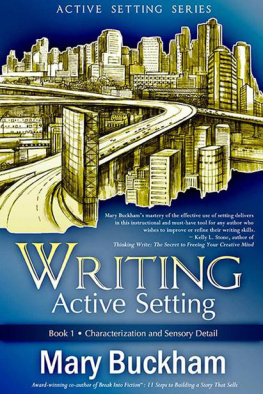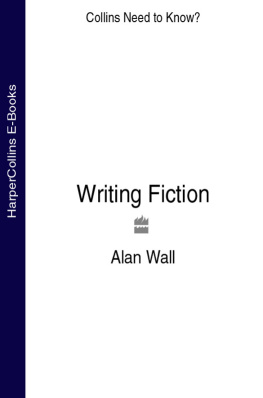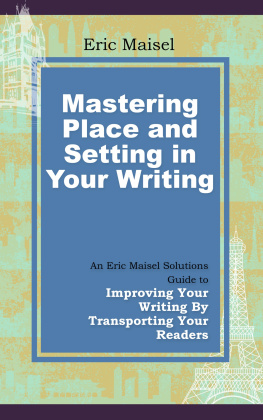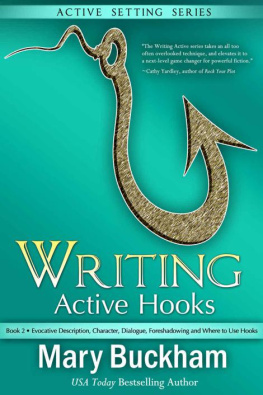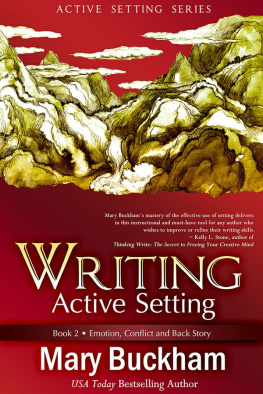Contents
Guide
A Writers Guide to Active Setting
How to Enhance Your Fiction with More Descriptive, Dynamic Settings
Mary Buckham

Cincinnati, Ohio
A Writers Guide to Active Setting. Copyright 2015 by Mary Buckham. Manufactured in the United States of America. All rights reserved. No part of this book may be reproduced in any form or by any electronic or mechanical means including information storage and retrieval systems, without permission in writing from the publisher, except by a reviewer, who may quote brief passages in a review. Published by Writers Digest Books, an imprint of F+W Media, Inc., 10151 Carver Road, Suite # 200, Blue Ash, OH 45242. (800) 289-0963. First edition.
For more resources for writers, visit www.writersdigest.com/ .
19 18 17 16 15 5 4 3 2 1
Distributed in Canada by Fraser Direct
100 Armstrong Avenue
Georgetown, Ontario, Canada L7G 5S4
Tel: (905) 877-4411
Distributed in the U.K. and Europe by F&W Media International
Brunel House, Newton Abbot, Devon, TQ12 4PU, England
Tel: (+44) 1626-323200, Fax: (+44) 1626-323319
E-mail:
Distributed in Australia by Capricorn Link
P.O. Box 704, Windsor, NSW 2756 Australia
Tel: (02) 4577-3555, Fax: (02) 4577-5288
E-mail:
ISBN-13: 978-1-59963-932-1

WritersDigest.com
Cincinnati, Ohio
Introduction
Setting can be one of the most underused tools in a writers toolbox, but it shouldnt be.
Setting involves much more than stringing together a list of adjectives or dumping a chunk of visual clues to orient the reader. It can create the world of your story, show characterization, add conflict, slow or speed up your pacing, add or decrease tension, relate a characters backstory, thread in emotion, and more. Some authors are known for creating Settings that are so deeply integrated into the story that when readers step away, they still find themselves in the place described on the page.
Think of Setting as the stage that contains your storyit should be as important as any character, whether you choose to write sparsely or in great detail. The Setting orients readers to the geography, climate, social context, time of the storys events, foreshadowing of unfolding events, architecture, and much more. When handled well, Setting can also have an impact on your readers thoughts and your characters actions, thus moving the story forward.
If handled poorly, Setting description can thwart or frustrate to the point where the reader wants to set the book down and walk away.
Setting can add so much to your story world, or it can add nothing. In creating Active Setting, you can develop subtext in your writinga deeper way for your reader to experience your story.
Instead of simply describing a place or thing for the sake of description, well look closely at how to maximize what you are showing the reader. Youll learn how to verbally illustrate a place and where to insert this information so the reader will understand the intention of your scenes and be pulled deeper into the story. In , well look at using Setting to reveal your characters and to add sensory details.
Youll also learn how to make sure your reader focuses only on details that are pertinent to the story.
NOTE: The details of your Setting must matter to your story.
For example, if youre showing the reader a room in a house, that room, and the details in that room, should show characterization, conflict, emotion, or foreshadowing. The description should be there for a reason instead of simply describing placement of objects in space.
Lets start with an overview of what Setting is and what it can be.
Overview
In this book well focus on keeping in mind three key elements in crafting Setting to make it active:
- You need to create the world of your story.
- Each character in your story experiences the story world differently.
- Your story world involves more than one sense.
What this means is that your role as a writer is to create the world of your story so that the reader not only sees it, but experiences every important detail.
Active Setting means using your Setting descriptions to add more to your story than a passive visual reference. This book will explain in greater detail how to make this happen regardless of what type of story youre crafting.
NOTE: If the details dont add to the story, leave them out. Every word choice you make in your story should be intentional and focus the reader on what you want. Dont waste their focus on trivial details.
Regardless of whether youre writing about a famous place that millions have seen in pictures or experienced in person, your characters perceptions of that world are what matters in your story. Youre not writing about any living room, small town, or large city; you are writing about a specific living room, small town, or large city and why those Settings matter to your character.
Pull the reader into your story by allowing them to experience the Setting on a deeper level. This can be the difference between standing on a beach facing the Pacific Ocean, feeling the sand beneath your bare toes, inhaling the scent of tangy salt spray, and hearing the roar and slam of the waves against the shore versus looking at a postcard.
Learning to write Active Setting is as easy as knowing when and where you want to ramp up your Setting details and why.
Ive had the privilege to work with thousands of writers in all genres over the years and to see them take the blah or non-existent Setting of their stories and make their passive Setting description work harder and do so much more than simply describe a place. Thats my wish for every writer who takes the time to study Active Setting.
Part One
Characterization & Sensory Detail
Chapter 1
Getting Started with Active Setting
Throughout this book well be looking at how you can ramp up elements of your story by how you use or do not use your Setting. Well start with an overview of why Setting matters to a story and see examples from published authors showing, in a variety of genres, how they maximized Setting in their novels. Always keep in mind that Setting is more than describing a place.
NOTE: Active Setting means using your Setting details to work harder and smarter.
First, you should focus on what seems like a basic assumption.
Your reader has never been in your worldwherever your world is.
It doesnt matter if its New York City and most of your readers live in Manhattan; your reader has never been in your world. The Setting and world youll paint on the page are more than a travelogue or a list of street names.
Not everything that a character sees, smells, tastes, or touches needs to end up in your final manuscript, but its a place to start. For example, a point of view (POV) character (the person whose thoughts, emotions, background, and worldview through which the reader experiences the story) who is miserable in a school environment will not see or notice the same items as a POV character who finds school a sanctuary and the center of her world.
As the author, you need to focus the reader on whats key about your POV characters world Setting and then bring that information to life through word choices, details, and how you thread those details together.


